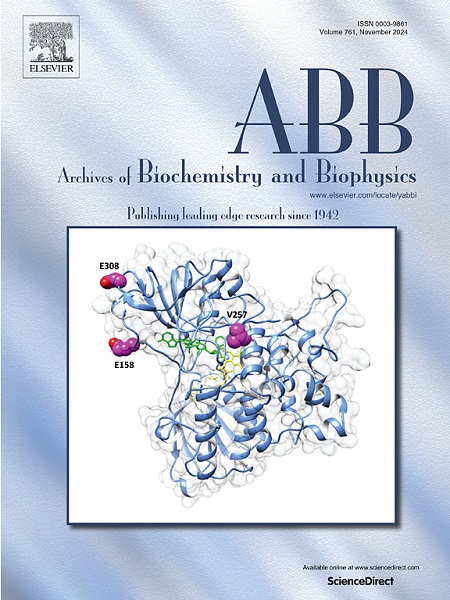FFA intervention on LO2 cells mediates SNX-10 synthesis and regulates MMP9 secretion in LX2 cells via TGF-β1
IF 3
3区 生物学
Q2 BIOCHEMISTRY & MOLECULAR BIOLOGY
引用次数: 0
Abstract
Background
Metabolic-associated fatty liver disease (MAFLD) is a public health concern. Transforming growth factor-β1(TGF-β1) plays an important regulatory role in multiple MAFLD stages, as it can promote the expression of matrix metalloproteinase-9 (MMP9) and promote liver fibrosis. Sorting nexin protein-10 (SNX-10) may be involved in the occurrence and development of fatty liver disease.
Methods
Free fatty acids (FFA) treatment was used to simulate the cellular lipid deposition stage of MAFLD and the interactions between cells were simulated via LX2 and LO2 coculture. The molecular interaction between the two cell types was studied via ELISA, immunoprecipitation, qPCR, and western blotting.
Results
In FFA-treated LO2 cells, intracellular TGF-β1 expression increased as lipid deposition increased. FFA-treated LO2 cells promoted the expression and secretion of MMP9 by LX2 cells through paracrine pathways. MMP9 secretion decreased with decreasing SNX-10 expression in LX2 cells. The interaction between MMP9 and SNX-10 was confirmed by coimmunoprecipitation. TGF-β1 promoted the synthesis of SNX-10 through the p38 MAPK pathway, and SNX-10 affected the secretion of MMP9 through protein interactions, thereby affecting the development of liver fibrosis.
Conclusions
FFA induced lipid deposition in LO2 cells, and TGF-β1 mediated the p38 MAPK pathway to promote SNX-10 synthesis and stimulate MMP9 secretion, thereby regulating the involvement of LX2 in the process of liver fibrosis.

FFA干预LO2细胞介导SNX-10合成,并通过TGF-β1调控LX2细胞MMP9分泌。
背景:代谢性相关脂肪性肝病(MAFLD)是一个公共卫生问题。转化生长因子-β1(TGF-β1)可促进基质金属蛋白酶-9 (matrix metalloproteinase-9, MMP9)的表达,促进肝纤维化,在MAFLD的多个阶段发挥重要的调节作用。分类连接蛋白-10 (SNX-10)可能参与了脂肪肝的发生发展。方法:采用游离脂肪酸(FFA)处理模拟MAFLD细胞脂质沉积阶段,通过LX2和LO2共培养模拟细胞间相互作用。通过ELISA、免疫沉淀、qPCR和western blotting研究两种细胞类型之间的分子相互作用。结果:在fa处理的LO2细胞中,细胞内TGF-β1表达随脂质沉积增加而升高。ffa处理的LO2细胞通过旁分泌途径促进LX2细胞MMP9的表达和分泌。LX2细胞中MMP9的分泌随着SNX-10表达的减少而减少。MMP9和SNX-10的相互作用通过共免疫沉淀得到证实。TGF-β1通过p38 MAPK通路促进SNX-10的合成,SNX-10通过蛋白相互作用影响MMP9的分泌,从而影响肝纤维化的发展。结论:FFA诱导LO2细胞脂质沉积,TGF-β1介导p38 MAPK通路促进SNX-10合成,刺激MMP9分泌,从而调节LX2参与肝纤维化过程。
本文章由计算机程序翻译,如有差异,请以英文原文为准。
求助全文
约1分钟内获得全文
求助全文
来源期刊

Archives of biochemistry and biophysics
生物-生化与分子生物学
CiteScore
7.40
自引率
0.00%
发文量
245
审稿时长
26 days
期刊介绍:
Archives of Biochemistry and Biophysics publishes quality original articles and reviews in the developing areas of biochemistry and biophysics.
Research Areas Include:
• Enzyme and protein structure, function, regulation. Folding, turnover, and post-translational processing
• Biological oxidations, free radical reactions, redox signaling, oxygenases, P450 reactions
• Signal transduction, receptors, membrane transport, intracellular signals. Cellular and integrated metabolism.
文献相关原料
公司名称
产品信息
索莱宝
Palmitic acid
索莱宝
Palmitic acid
麦克林
Oleic acid
麦克林
Oleic acid
 求助内容:
求助内容: 应助结果提醒方式:
应助结果提醒方式:


